

BC’S EQUINE LIFESTYLE



We are Canada’s most trusted insurance broker for horse enthusiasts and have been for decades. Ask us about coverage for:
• Horse Mortality Coverage
• Commercial Equine Liability
• Coachs/Officials
• Clubs
• Horse Shows
• Equine & Livestock Trailers

BC’S Equine Lifestyle
FALL 2025
Published quarterly by
Horse Council BC
27336 Fraser Hwy, Aldergrove BC, V4W 3N5
T: 604-856-4304
F: 604-856-4302
Toll Free: 1-800-345-8055
www.hcbc.ca
On the cover: Elizabeth Cochran & Nancy Garner at the BC 55+ Games Nanaimo
Horse Council BC is a membershipdriven not-for-profit association representing the interests of the equine industry in all sectors throughout British Columbia.
Horse Council BC represents the equine industry in agriculture, industry, sport, and recreation through education, grant funding, club support, government advocating, liability insurance, and participant programs.

Horse Council BC gratefully acknowledges the financial support of the Province of British Columbia through the Ministry of Tourism, Arts, Culture and Sport
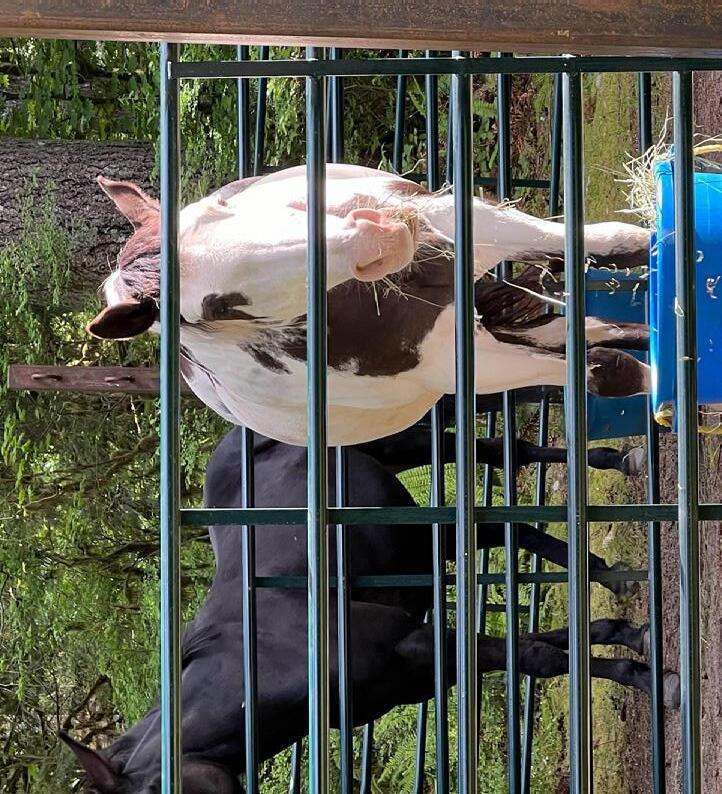


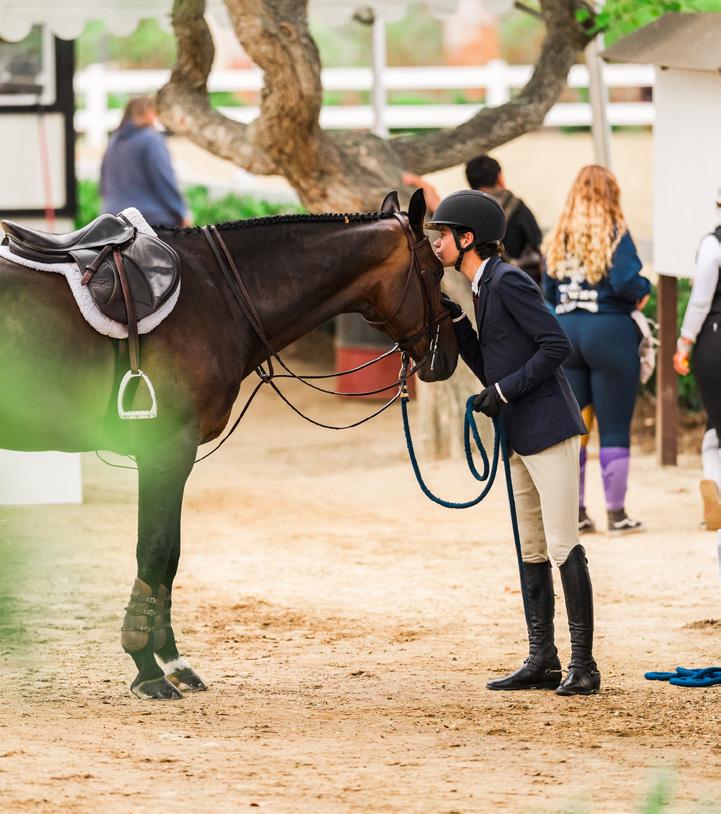

14. 55+ Games Nanaimo
HCBC Board Chair’s
Message
By Lynda Atkinson| HCBC Board Chair

As the fall season settles across British Columbia and the show rings quiet after another successful competition season, I hope this edition of our magazine finds you reflecting on a year of great rides, rewarding experiences, and memorable moments with your horses. On behalf of Horse Council BC, thank you for your continued support and commitment to our province’s thriving equestrian community.
As we move into membership renewal season, I encourage you to renew your HCBC membership and continue to be part of a strong and united voice for horses and equestrians across the province. Membership also comes with valuable benefits, including automatic liability insurance, additional optional insurances available for purchase, access to educational resources, and exclusive member discounts. By renewing, you are supporting the programs and initiatives that keep equestrian sport and recreation thriving in British Columbia.
We’re also excited to share that HCBC is expanding opportunities for learning this fall and winter. Members can look forward to an increased schedule of webinars and workshops designed to support riders, coaches, officials, and clubs. In addition, we have several new programs and initiatives on the horizon that will continue to strengthen our community and promote equine welfare throughout the province.
As always, we extend our gratitude to the many volunteers, organizers, and participants who make equestrian activities possible year after year. Whether you compete, trail ride, volunteer, or simply enjoy the presence of horses in your life, your involvement helps keep our equine community strong.
Wishing you a wonderful fall season.
Lynda Atkinson Chair, Horse Council BC
HCBC SummariesMembership
Below are summaries for the Affiliates, Businesses, Clubs and Individual/Family Membership. Most people require the Individual/Family membership. Below will be a brief description of each membership
Affiliate Membership:
Affiliate Membership with Horse Council BC is available to BCbased non-profit or charitable equestrian/equine organizations that are legally incorporated and meet specific criteria. Applications must include a completed form, current society certificate, and a $199 non-refundable fee (insurance not included). Legally incorporated branches are covered under the Affiliate’s membership, while separate entities must purchase Club Membership. Benefits include membership processing, access to group insurance, eligibility for HCBC grants, event promotion, educational resources, and directory listings. All applications are reviewed annually by the HCBC Executive for eligibility and alignment with HCBC goals. For more detailed information, please visit the website www.hcbc.ca
Business Membership:
An HCBC Business Associate membership offers businesses increased visibility through affordable marketing to over 24,000 members and 2,000 daily website visitors. For $99 + tax (nonrefundable), businesses receive a 12-month listing in the HCBC Business Directory, one free ad, a 30% discount on advertising, sponsorship opportunities, business referrals, and the chance to spotlight their services. Insurance is not included, but access to group commercial insurance is available through Acera Insurance. For more detailed information, please visit the website www.hcbc.ca
Club Membership:
To qualify for HCBC Club Membership, organizations must be BC-based equestrian or equine non-profits or charities with a filed legal constitution, have members, ensure all riding/driving members hold individual HCBC memberships, carry club insurance for the calendar year, and comply with HCBC policies. Applications must include a completed form, current insurance certificate, society number, constitution and bylaws, and the $99 + tax non-refundable fee. Membership expires December 31 of each year and does not include insurance. Benefits include eligibility for HCBC grants, promotion through the Club Directory and website, access to group insurance via Acera Insurance, ability to collect HCBC fees at events, and access to
promo materials and membership verification tools. For more detailed information, please visit the website www.hcbc.ca
Individual & Family Membership:
Horse Council BC individual and family memberships are non-refundable, expire annually on December 31, and include up to $5 million in personal liability insurance. Individual memberships are for youth (under 19) and adults (19+), while family memberships (available only at signup or renewal) include 3 people—either 1 adult and 2 youth or 2 adults and 1 youth—with additional youth charged $19.95 (tax included) each (maximum 2 adults per family). Members receive their own HCBC number. Email consent is required for account access, and promotional emails can be unsubscribed from at any time. Members can also join HCBC affiliates like Dressage BC and EVABC during registration.
For more detailed information, please visit the website www. hcbc.ca

Acera Insurance Services
Why Upgrading to Full Mortality Coverage Is a Smart Move for PTSO Members

As a valued member of the PTSO, your commitment to protecting your equine partners is commendable. While Members Named Perils coverage offers a foundational level of protection, upgrading to Full Mortality coverage provides a more comprehensive safety net—one that reflects the true value and importance of your horse.
Understanding the Difference
Members Named Perils coverage is limited to specific, listed causes of death such as fire, lightning, or transportation accidents. While these are important, they represent only a fraction of the risks horses face daily. Full Mortality coverage, on the other hand, protects against death from any cause, including illness, injury, or natural causes—unless specifically excluded. This broader scope ensures that you’re not left vulnerable to unexpected and costly losses. Upgrading also gives you access to valuable endorsements like Medical and Surgical coverage to offset unexpected veterinary care.
Peace of Mind for Every Scenario
Horses are unpredictable by nature. Whether it’s a sudden colic episode, a pasture accident, or an unforeseen illness, Full Mortality coverage gives you peace of mind knowing that your investment is protected. It’s not just about financial reimbursement—it’s about having the confidence that you’ve done everything possible to safeguard your horse’s welfare.
Tailored for Responsible Owners
Upgrading to Full Mortality coverage reflects responsible ownership. It shows that you value your horse not just emotionally, but practically. This coverage is especially important for those who compete, breed, or rely on their horses for professional or recreational purposes. It ensures continuity and support in the face of adversity.
Affordable and Accessible
Many members are surprised to learn that Full Mortality coverage is more affordable than they expect. With flexible options tailored to your horse’s age, use, and value, upgrading is a smart financial decision. Plus, as a PTSO member, you are automatically eligible for preferred rates and streamlined underwriting.
Make the Move Today
Your horse is more than just an asset—they’re a partner, a companion, and a source of joy. Don’t let limited coverage leave you exposed. Upgrading to Full Mortality coverage is easy, and our team is here to guide you through the process.
To learn more or request a quote, visit acera.ca/equine If you have questions, contact your Acera equine insurance advisor today at 1-800-670-1877


HCBC Awards Program
Now Accepting Nominations
Horse Council BC is proud to announce that nominations are now open for the 2025 HCBC Awards, including the Sherman Olson Lifetime Achievement Award and our newly expanded program recognizing volunteer excellence in Community, Sport, Recreation, and Industry.
Volunteers are the foundation of BC’s equine community. From local clubs and sport development to advocacy and innovation, their dedication shapes a strong and inclusive equestrian culture across the province. This year, HCBC is excited to broaden its awards program to celebrate the many ways members contribute to our equine community. These new categories highlight outstanding volunteers of all ages who are driving progress and making a lasting difference across BC.
The Sherman Olson Lifetime Achievement Award continues to honour individuals who have dedicated their lives to the advancement of the equine community in BC. Established in 1981 and renamed in 2013 to honour founding member Sherman Olson, this award remains HCBC’s highest recognition of long-standing commitment, leadership, and service.
Award Categories:
Bob James Community Volunteer of the Year
Recognizing volunteers who go above and beyond in their local communities—organizing events, supporting therapeutic riding centres, improving trail access, or leading projects that make a positive impact across the region.
Sport
Celebrating those who strengthen equestrian sport in BC through athlete development, grassroots initiatives, and efforts that help the sport thrive at all levels.
Recreation
Honouring individuals who promote safe, accessible
recreational riding through advocacy, trail projects, and collaboration with land managers and community partners.
Industry
Recognizing volunteers who bring innovation and leadership to BC’s equine sector through education, welfare initiatives, crisis support, or the advancement of equine care and policy.
Sherman Olson Lifetime Achievement Award
Presented to a BC resident whose lifelong contributions through leadership, mentoring, and advocacy have left an enduring mark on the province’s equine industry.
Nominations close November 30th
Criteria:
- Nominations must be for an HCBC member in good standing
- 5 Nominators are needed, who must all be current HCBC members in good standing
- Nomination form must be complete and in one package to be considered (all documents in one email)
- All nominations MUST be submitted on or before the nomination deadline to be accepted for the current year.
- The Awards Committee reserves the right to re-direct a nomination into a more appropriate award category.
- It is at the discretion of the Awards Committee whether or not to give out an award.
- Current HCBC Staff and Directors are not eligible to be nominated for the Volunteer Annual Awards.
Download Nomination Forms: https://hcbc.ca/about/hcbcawards/
Coaching The End of Temporary Coach Licensing: How to Stay Current as an Equestrian Coach
If you are actively participating at Equestrian Canada sanctioned competitions, you are most likely aware of the changes on the horizon for coaching at these competitions. Since 2022 the coach status program was introduced to elevate the standard for equestrian coaches in Canada. The sport world is changing dramatically with a call for greater measures to ensure a safe sport environment for all. The most recent coaching symposium in Calgary in September highlighted a safe sport talk with Allison Forsyth former Alpine Skier who experienced sexual abuse from her coach during her high performance career. Allison’s story was not your typical talk hammering down on policies and procedures but an inspirational story telling of how we need to shift the culture of sport from grassroots level and beyond.
Coach licensing has been brought forward as a method to help address the need for better screening of coaches and to ensure a standard is being met. The end of temporary coach licensing will take place December 31, 2025. In order to receive a coach license you must submit the following documentation and meet the following criteria:
• Step 1: Screening Disclosure
• Step 2: Criminal Record Check/Free Sterling Backcheck link
• Step 3: Vulnerable Sector Search
• Step 4: Coaching References
• Step 5: First Aid Training
• Step 6: Concussion Education
• Step 7: Training for the Prevention of Maltreatment of Sport
• Step 8: Insurance
• Step 9: Coach Certification/Verified Expertise
There is a step-by-step online platform via Equestrian Canada’s E-Campus that allows you to obtain your license. Step nine may
take some time and extra planning depending if you need to obtain your Equestrian Canada National Coaching Certification Program (NCCP) certification.

Following
the Path to Certification
Equestrian Canada works in partnership with the Coaching Association of Canada to provide an equestrian specific NCCP. This certification pathway enables coaches to obtain the following certifications: instructor, competition coach, competition coach specialist, or high performance. This certification is administered by the Provincial/Territorial Sport Organization (PTSO) which is Horse Council BC in our province. Your certificate can be obtained via in-person evaluation, video evaluation or the region 1 cohort (online training and video evaluation). Horse Council BC recognizes that there is an increase in demand for evaluations and is looking into additional in-person evaluations in 2026. Video evaluations are another great option for obtaining your certification and are flexible to fit your schedule. Our cohort training is a fantastic way to prep and be evaluated, however, it requires meeting at a specific time weekly (sometimes twice a week) over a threemonth period.
Club Feature Vernon District Riding Club
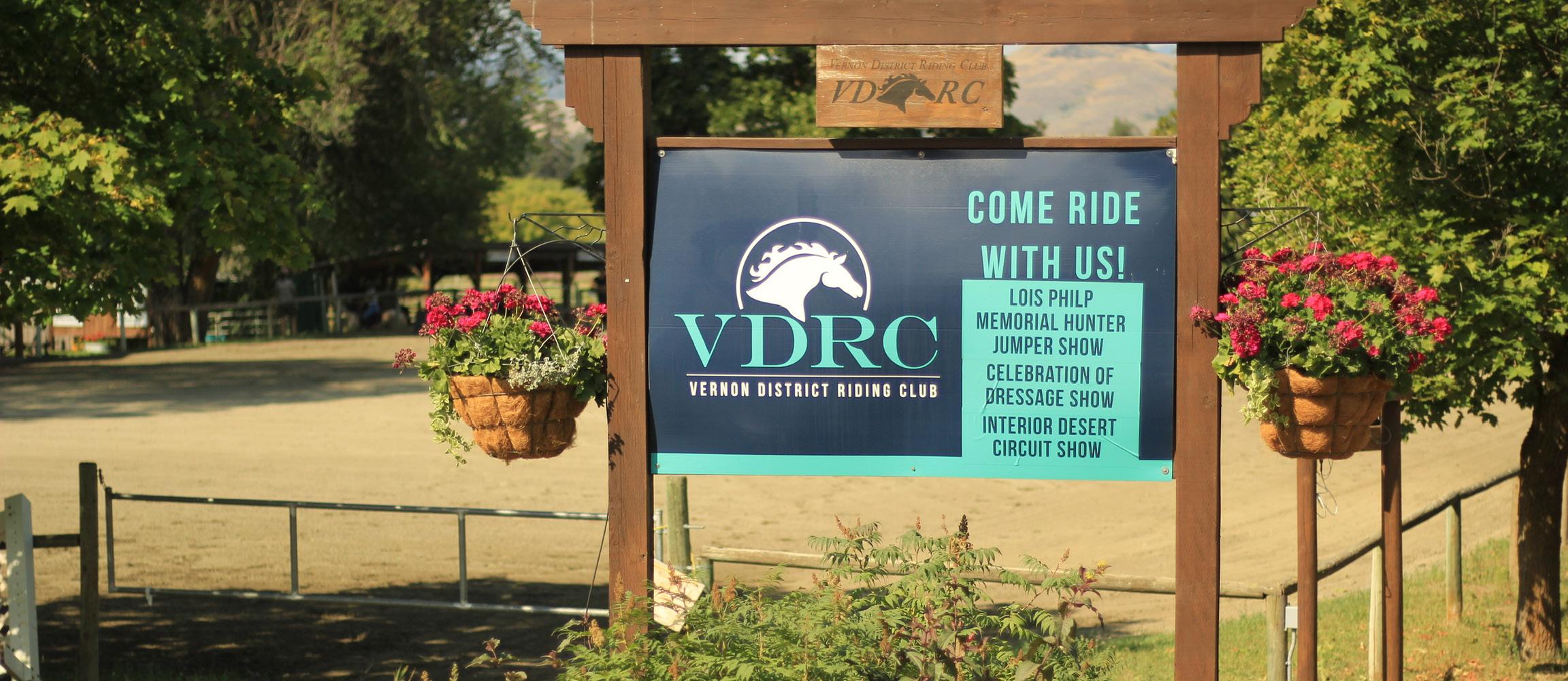
The Vernon District Riding Club (VDRC) is a non-profit society that brings together equestrians of all ages, skill levels, and disciplines to ride, learn, teach, compete, and share their passion for horses. The club celebrates a unique connection to the District of Coldstream, City of Vernon, and the Okanagan Valley while fostering opportunities to build community among members and non-members alike. Horse Council BC was lucky to learn of the club’s rich history and bustling activity from President Sandra Marbry.
The club’s roots trace back to 1912, when a group of horse enthusiasts formed a polo club. By 1932, the group adopted the name Vernon District Riding Club, and in 1943 it became formally organized with Hal Symonds elected as president and Miss Phyllis French as the first secretary. Today, the Vernon District Riding Club proudly includes third- and fourthgeneration families, continuing a century-long tradition of horsemanship and community spirit.
Each season begins with a Spring Cleanup in early April, followed by the first jumping clinic of the year. VDRC runs an HCBC-sanctioned hunter/jumper series, the Interior Desert Circuit (IDC), in collaboration with the Kelowna Riding Club. In May, they host Bronze and Gold Dressage shows, followed by a Bronze-level Hunter/Jumper show in June. Throughout the summer, riders can enjoy clinics, percentage days, and clear round evenings. A highlight of the year is the elegant White Table Event in August—a glamorous evening of gourmet food,
live music, riding demonstrations, and community celebration. The season concludes with Hunter Derby Dayz in September or October—an opportunity for riders to practice derby-style courses and receive feedback—before the fall cleanup closes out the year on the last weekend of October.
Among the many memories shared at VDRC, one in particular stands out: a longtime member who began as a junior rider was proposed to during a costume class at a summer show. The surprise engagement delighted the crowd and became a cherished part of the club’s history.
Members often describe the Vernon District Riding Club as a local gem—peaceful, welcoming, and full of heart. They appreciate the beautiful, park-like grounds, the dedication of volunteers, the familiar faces that have been part of the community for decades, and the sense of nostalgia for those returning year after year, now sharing it with their children. Riders enjoy open access to multiple arenas, including a dressage ring, jumper ring, open ring, and round pen, and always find a friendly face ready to help.
Looking ahead, the club plans to expand its offerings by introducing Working Equitation and Mountain Trail clinics for the 2026 season. They are also exploring opening their scenic facility for weddings and photo sessions, allowing more people to experience the charm and beauty of the Vernon District Riding Club.
Member Feature
Dane Anson

HCBC is beyond proud of the recent success of member Dane Anson (15) of Nanaimo, BC and his owned horse Celestino, who won the USHJA Gladstone Cup Equitation Classic – West. This triple component class was held in conjunction with the USEF Junior Hunter National Championships, which showcases some of the best junior hunter talent from across the West coast. Dane remained consistent throughout the competition, laying down beautiful rounds in the classic, handy, and horse swap to secure the win. We interviewed Dane about his start in riding, what equestrian life looks like inside and outside of the show ring, and competition advice for young riders like him.
How old were you when you first started riding?
When I first started riding I was 7, almost 8 years old. My first ride was on October 6, 2017 and I have been riding consistently since.
Of all the sports out there, what made you choose this one?
I have always loved horses and knew I wanted to ride since I was a young child. I loved going to local rodeos when I was young because of the horses and that sparked my interest in them. My mom also was involved with horses but stopped before I was born, making me have a love for them. I tried other sports but none of them were really a fit. Since I started riding, I have only done this sport as it takes up so much time out of your day, leaving not much space for another sport.
Can you walk us through what a normal day at the barn looks like for you?
I go to the barn everyday even if I’m not riding. I enjoy spending time with the horses and creating a bond with them, grooming them, taking them for a graze, etc. When I am home and not showing, I ride 5 days a week. I have one or two jumping lessons a week with Jenny Payne and on the weekends, I have
Dressage lessons with Libby Naylor, leaving a day or two for hacking. We spend a lot of time at the barn with the horses but it is a routine now and we love it.
Do you have any competition rituals or things you do to hype yourself up before showing?
Before I show I always look at my course and visualize it. It is oddly realistic in my mind and it is quite effective in how I ride the course and remember it. I used to have lucky socks that I’ve had since I was 8 I would always wear when competing with my old horse. Now, I just like to be calm before I go, so I like to take a moment to breathe and go over my course.
Tell us about your horse Celestino. How would you describe his personality, and what he’s like in the ring versus on the ground?
Celestino or Tino known in the barn, is a 7-year-old Dutch Warmblood Gelding. He started as a catch ride at Desert International Horse Park this year. I really enjoyed riding him and fell in love with him. Tino’s personality is the best—he has the best brain and [is] always willing to do anything I ask. He is so gentle and always wanting cuddles when grooming and hanging out with him, but in the ring he is always trying 110% and wanting to win.
What was it like stepping into the ring to compete in the Gladstone Cup? What did winning it mean to you?
Stepping into the ring for the Gladstone Cup was truly unforgettable. I felt a mix of nerves and adrenaline, but also a strong sense of focus. Just having the privilege to walk into the ring for that class meant so much—qualifying for it, riding against incredible competitors, and working alongside the best trainers; Archie Cox and Karli Postel and with such an amazing horse. Winning it was incredibly meaningful. It validated the hard work, the early mornings, and the constant support from my trainers and family. I am immensely proud to be part of history; not only as the first Canadian to win the class, but also the youngest horse and youngest rider so far. It’s a moment I’ll carry with me forever.
Do you have any words of advice for fellow young equestrians pursuing competition?
My biggest advice that has helped me would be to not worry about who you are against or trying to beat them, because, at the end of the day, you are truly against yourself. All you can do is try to get the highest score or best round that you can achieve. If it beats others, well, then awesome — but if it doesn’t, you did everything you could, and you should be proud of that.

My Heart Horse
That Once-in-a-Lifetime Equine Companion
Horse Council BC recently reached out to our members to share stories about their Heart Horses—those special equines that hold a unique place in our hearts, whether through their loyalty, spirit, or the extraordinary bond they share with their human companions. We were overwhelmed by the response, receiving countless incredible stories, and we’re excited to share a few of these heartwarming tales with you.
Pictured to the right is Ahoora Takhshidi and his beloved friend Dawan celebrating Ahoora’s 13th birthday. His mother tells a beautiful story of the special bond these two share.
My son, Ahoora, is a 13-year-old boy who has autism. He is extremely intelligent, gentle, and deeply connected to two things in life: horses and the piano. His best friend and soulmate is a brown and white horse named Dawan. This story is about their beautiful bond, which continues to shape my son’s life in remarkable ways.
Ahoora began visiting Dawan when he was around seven years old, and ever since then, the two have been inseparable. Rain or shine, Ahoora refuses to miss a single riding class. Once, when Dawan caught a cold, Ahoora was the one who noticed the change. He texted his instructor and said, “Please don’t make Dawan work today. He’s not feeling well.” That day, Ahoora cried for hours in his room because of Dawan’s illness. I’ve never seen him react like that to anyone else being sick—not even his own family.
What makes their relationship even more magical is that Ahoora composed a piano piece just for Dawan. Whenever he misses him, he plays the song at home and tells us, “When I play this, I feel like Dawan is standing right in front of me.” This emotional connection through music is something truly powerful.
Despite our financial struggles, Ahoora’s determination never faded. His dream is to become both a horseback riding instructor and a piano teacher one day. He has already passed RCM Level 6 in piano and is working hard toward achieving his goals—all while carrying the love of Dawan in his heart.

Their friendship is not just between a boy and a horse—it’s a story of healing, purpose, and unconditional love. For Ahoora, Dawan isn’t just a horse. He is a friend, a comfort, and the reason to keep moving forward.
“It was a deeply emotional moment for all of us. Ahoora’s eyes sparkled with joy, and we could see genuine emotion in Dawan too. It felt as if they both truly understood the significance of that shared moment. My husband and I, along with Ms. Lindsay, were moved to tears witnessing their bond.”
-Ahoora’s mother, regarding the memory of his birthday depicted above
More Great Stories...

Honey & Family
“For us, Honey has become more than a horse. She has become a mirror. She reflects back a calmer version of all of us — one that remembers to breathe, to slow down, and to be present... Honey didn’t just become our horse. She became the heart of our home.”
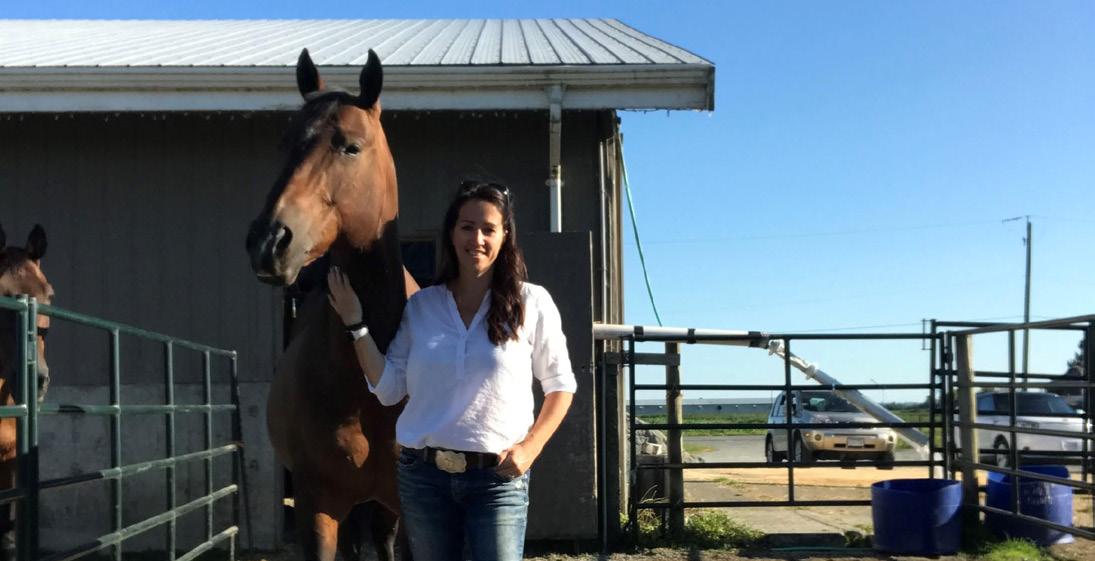
Heather & Penny
“I drove to a ranch past Ashcroft and met the most beautiful bay mare in the world! I bought her for $1200 and as we drove home there were tears of joy! I was 40 years old – she was my birthday present. I lost Penny earlier this year – I miss her so much. I will always be so thankful for the way she took care of me. Penny was my heart horse and I am lucky that she was my first one.”
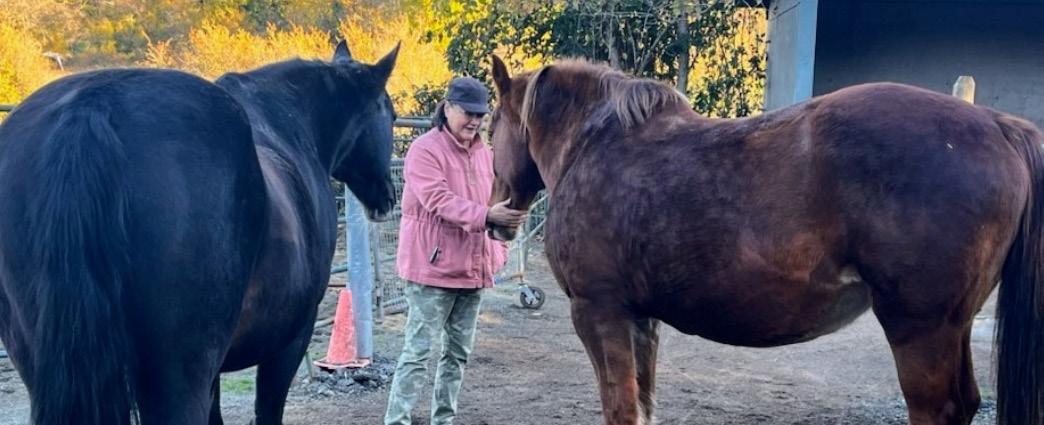
“My “heart herd” have taught me the meaning of belonging, the pleasant surprise of making new friends and how these connections are necessary to live a full life... I have gained a deeper understanding of myself, enabling me to have a deeper appreciation of the world around me.”
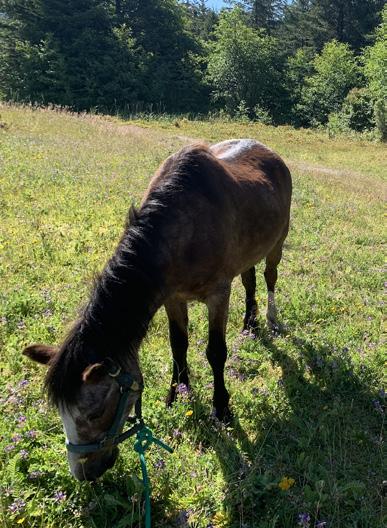
Layla & Echo
“It was a friendship that shaped me, built on trust and time and thousands of shared footsteps. Echo may be older now, her steps slower, her coat flecked with grey. But to me, she’ll always be that wild little pony on the beach — pulling toward the dunes, ears pricked to the wind, carrying me into the kind of magic that only horses can give.

“She has given me a quiet place to land at the end of the day – I drift off to sleep envisioning her soulful eyes and wonder if she thinks about me as well. At this point I cannot imagine my world without her. She has given me something to love again, something to care for and for that I can never thank her enough.

“If horses can communicate, he was speaking loud and clear: he needed someone to trust, just as I needed a horse to trust. More than anything, I’m grateful—for the unexpected path, the healing, and for finding my heart horse.”
Catherine & Her “Heart Herd”
Mona & Raya
Vivian & Bud

Club Feature
Nanaimo Equestrian Association
The Heart of Nanaimo’s Equestrian Community: The Story of the Nanaimo Equestrian Association
The Nanaimo Equestrian Association (NEA) has been part of the local horse community for generations, with roots going all the way back to the 1930s. It all started on what was once a 160-acre farm owned by Frank and Hanna Beban. The Bebans built a horse racing track and beautiful gardens on their land, creating what would eventually become a hub for equestrian life in Nanaimo.
After Frank Beban’s passing, the City of Nanaimo purchased the property in 1953 and renamed it Exhibition Park. Not long after, a passionate group of local riders and volunteers saw the potential to turn the space into something truly special—a place dedicated to horses, learning, and community.
That vision came to life in the early 1980s thanks to the leadership of Bus MacDonald and the Nanaimo & District Equestrian Association. With the help of groups like the VIEX, Tractor Club, Pony Club, and Arabian Horse Society, the team built major infrastructure including the Agriplex (completed in 1981) and the stall barns that followed a few years later.
The hard work and dedication of early supporters like Bus MacDonald, Shirley Dixon, Gerald McDonald, Barb Parker, Lois Shaw, and Tom Sampson turned a dream into a thriving equestrian centre. Built on community spirit and a shared love of horses, that same energy still drives the NEA today.
More Than Just a Riding Club
What really makes the NEA stand out is that it’s not just a riding
club—it’s the managing organization for the entire Beban Park Equestrian Centre. That’s a rare role for a volunteer-run, nonprofit group, and one the NEA takes great pride in.
The facility offers just about everything an equestrian could ask for: three large arenas (both indoor and outdoor), multiple barns, modern jumps, show offices, meeting spaces, and lots of trailer parking. Whether you’re schooling a young horse, hosting a clinic, or preparing for a show, Beban Park has the space and resources to make it happen.
But beyond the infrastructure, what makes the NEA truly special is its people. The Association was built by local horse enthusiasts for local horse enthusiasts. It’s inclusive and welcoming—riders of all disciplines and backgrounds come together here, from dressage and jumping to western and trail. The NEA is as much about community as it is about riding.
Upgrades That Make a Difference
Over the last few years, the NEA has worked hard to improve and modernize the Beban Park Equestrian Centre. Every upgrade has been carefully planned and carried out by volunteers, with safety, functionality, and user experience in mind.
One of the most noticeable changes is the new LED lighting in the indoor arena. The difference is night and day—literally! The lighting now provides bright, even coverage with no shadows, creating a safer and more enjoyable space for everyone who rides there.
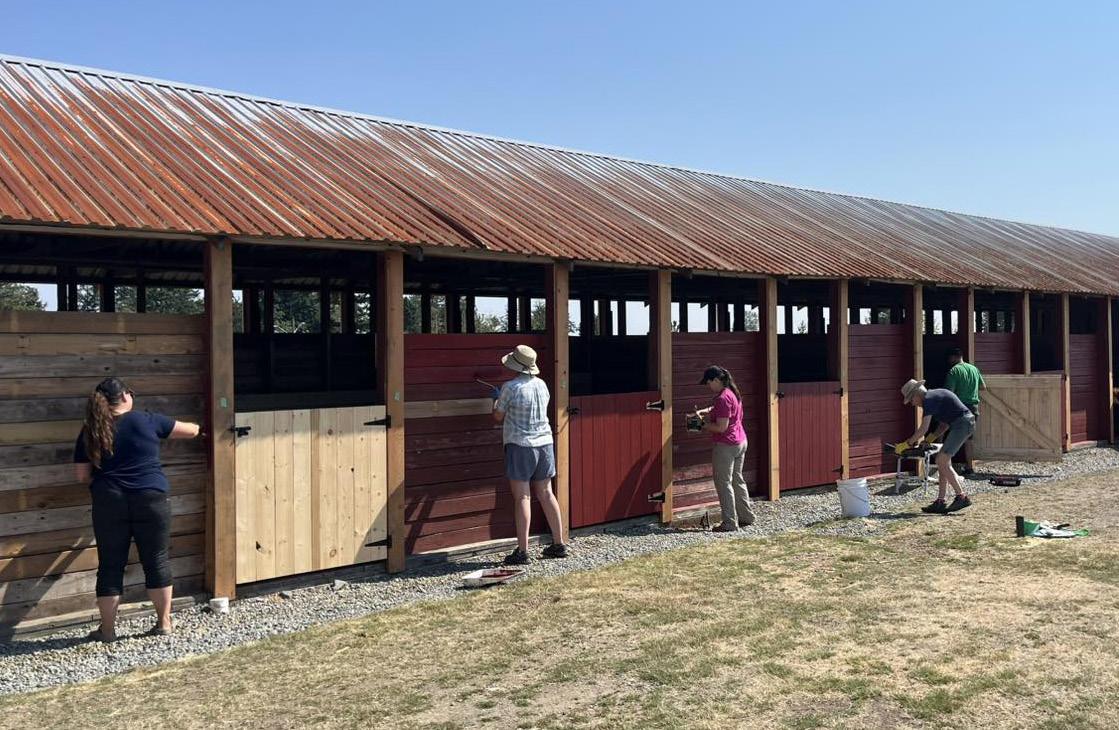
The NEA also tackled drainage problems in barns 3 and 4 by installing new perimeter drains. After assessing the situation, they decided the best long-term solution was a rebuild, so volunteers rolled up their sleeves and got to work. This summer, the team took another big step by removing barn 2 to create much-needed parking and trailer space for shows and daily use. Staying true to their commitment to sustainability, the wood from barn 2 was repurposed to refurbish barns 3 and 4— giving the old material a new life.
All these efforts show the NEA’s ongoing dedication to maintaining and improving this important community-owned facility. Thanks to their volunteers, Beban Park continues to grow as a welcoming, professional, and multi-use space for riders and community groups alike.
Building a Stronger Community
These upgrades mean a lot to the equestrian community—and to Nanaimo as a whole. For riders, the improvements have created a safer, more functional, and more enjoyable place to ride, train, and compete. With better lighting, improved barns, and expanded parking, the centre can now support more clinics, shows, and grassroots programs.
The NEA’s work also opens the door for more youth programs and community use. With better facilities, the Association hopes to see more young riders, riding schools, and clubs hosting events and lessons at Beban Park. The centre isn’t just a venue—it’s a community hub where people come together to learn, connect, and grow.
And it’s not only for horse events! The space regularly hosts non-equestrian gatherings as well, making Beban Park a true shared asset for everyone in the area.
Memories That Last
Over the years, countless memories have been made at Beban Park—from first lessons to show-day victories. What really stands out are the stories of young riders who grew up here, learning through Pony Club or local clinics, and later returning as instructors, volunteers, or mentors to the next generation.
Show season is always a highlight at the NEA, with riders from all disciplines cheering one another on, sharing advice, or helping a nervous competitor before their first class. It’s a place where friendships are formed, confidence grows, and the love of horses brings everyone together.
One recent clinic really captured that spirit. Riders commented on how the upgraded lighting and refurbished barns made the facility feel safer, more professional, and more welcoming— something that made them proud to show visiting coaches what their community has built.

Looking Ahead
The NEA isn’t slowing down anytime soon. The Association’s focus moving forward is to keep improving Beban Park as one of Vancouver Island’s leading equestrian facilities. Plans include upgrading footing in the outdoor arenas, ongoing maintenance to existing structures, and expanding educational opportunities for riders, coaches, and clubs.
A big part of the future vision is collaboration—strengthening partnerships with other local equestrian groups, schools, and community organizations to grow participation and create new learning opportunities. The goal is simple: to keep Beban Park welcoming, inclusive, and accessible for riders of all ages and disciplines.
The Spirit of the NEA
At its heart, the Nanaimo Equestrian Association is about people coming together through their love of horses. The club runs entirely on volunteer power—people who give their time and energy to keep the facility safe, beautiful, and thriving.
From families spending weekends at the barns to lifelong horse lovers sharing their knowledge, the NEA represents the very best of community spirit. It’s a place where people connect, skills grow, and the joy of working with horses is shared by all.
The NEA’s legacy—built on hard work, dedication, and passion—continues to shine through in every project, event, and smiling face at Beban Park. It’s a place where the past is honored, the present is celebrated, and the future of equestrian life in Nanaimo looks brighter than ever.
2025 BC 55+ GAMES –THANK YOU!

The 55+ Games were held September 9–13, 2025 at Beban Park in Nanaimo, featuring exciting equestrian disciplines including Working Equitation, Dressage, Western Dressage, and Working Hunter.
A huge thank you goes out to all participants, volunteers, and spectators who made this year’s Games such a success. Special recognition goes to the Nanaimo Equestrian Association and the many volunteers who worked tirelessly behind the scenes, with particular thanks to Jacquline Pieters (Sport Chair & President of NEA), Sandy Mohr (Sheriff), Rick Kowalzik (tractor support), and April LeNeveu.
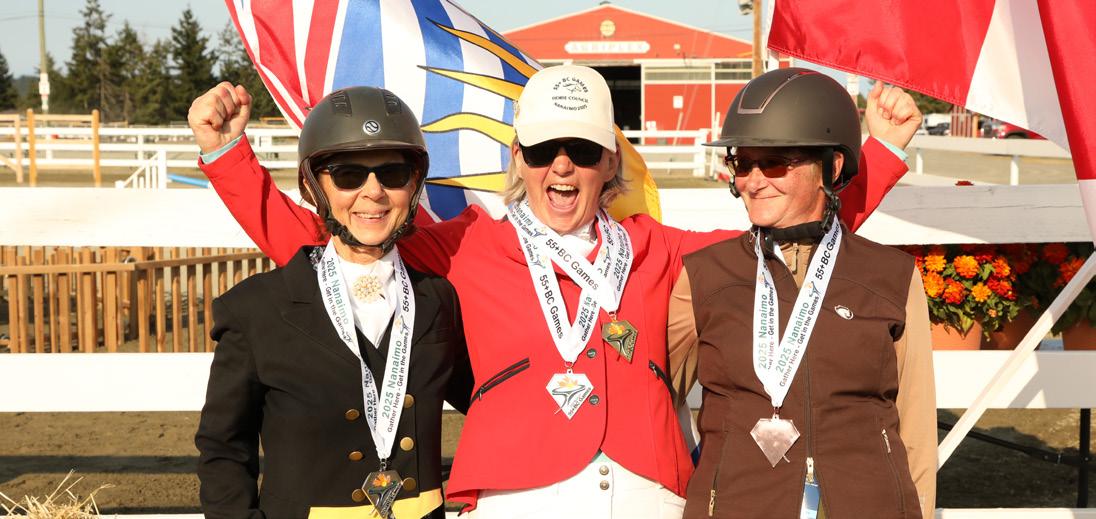
We extend our appreciation to the judges—Doreen Horsey, Melanie Houston, Danalynn Rooks, and Peter Holmes—as well as the dedicated Discipline Chairs: Jane Stone, Glynis Boggs O’Shea, and Monique Fraser. Thank you also to Natasha James for stepping in wherever needed, and to Rob Bau & Arbutus Meadows for the generous use of their jumps.
Full results can be found here: hcbc.ca/competitions/55-bcgames
Save the Date! The 2026 BC 55+ Games will be held in Kamloops, September 8–12, 2026. We are looking for a Sport Chair for Kamloops, if you are interested please email competition@hcbc.ca.
Hosting a successful Games over four days has confirmed that the NEA grounds are in top competition-ready shape. Please continue to support them so we can keep equestrian events thriving in BC!

Creating a Safer Landscape While Road Riding in BC
Being a Vulnerable Road User – 2024 legislation
In June of 2024, the provincial government updated the legislation to include vulnerable road users.
“Vulnerable road users include pedestrians, cyclists, motorcyclists, individuals on animals or in vehicles pulled by animals, and people who use electric wheelchairs, mobility scooters and electric kick scooters.”
When passing these road users, drivers must keep a minimum of distance of:
• 1 metre on highways with speeds of 50 km/h or less; and
• 1.5 metres on highways with speeds of 51 km/h or more
• Drivers interacting with vulnerable road users who are in separated and protected cycling lanes and on sidewalks: 0.5 metres
Reporting Road Issues: What to Do When you Have a Near Miss or Accident
As a vulnerable road user the onus is on the vehicle operator to ensure your safety—but sometimes, riders encounter drivers whose behaviour puts both horse and rider at risk. Knowing how to stay calm and how to properly report an incident can make all the difference. Doing the best you can to prepare your horse for rides on the road is essential to a positive experience as well.
If You Encounter an Aggressive Driver
Even the best drivers can make mistakes, but when tempers flare, it’s important to keep your cool.
DO:
• Recognize that everyone makes mistakes now and then.
• Calm yourself by talking through the situation.
• If the situation warrants and you’re in a safe location, call 911.
• Count to 20, take a few deep breaths, and relax.
DON’T:
• Get angry, gesture, or yell back. Escalating the situation can make things worse.
Making a Complaint to Police
If you decide to file a complaint, the most important detail to note is the license plate number of the offending vehicle. Write it down immediately and keep that record—this is what police
need to begin an investigation.
Try to record as many details as possible:
• Who was involved
• What happened
• Where it occurred
• When it took place
• Why it was concerning
The more information you can provide, the better the chances are that police can follow up effectively. Write everything down as soon as possible so details aren’t forgotten.
If the driving behaviour is serious or poses immediate danger, call 911 right away. For less urgent incidents, contact your local police non-emergency line as soon as you can. Once you’ve made your report, ask for the file number associated with your complaint—this will allow you to follow up later if needed.
If You Have a Near Miss While Riding
It’s not easy to focus on license plates when someone’s driving too close or behaving aggressively—but every report matters. The more riders report near misses and dangerous encounters, the more aware local authorities become that a problem exists.
To stay safe while riding near roads:
• Keep your cell phone in your pocket, not on your saddle.
• Always carry identification, a hoof pick, and a pocket knife.
• Let someone know where you’ll be riding and when you plan to return.
• Whenever possible, ride with a buddy.
Learn More
For additional guidance on how to make a complaint to police or report unsafe driving, visit the DriveSmartBC website.

Helping Horse Owners and Transporters Understand Canada’s Regulations for Compromised and Unfit Animals

By Mikki Shatosky
The Horse Welfare Alliance of Canada (HWAC)
Transporting horses isn’t just about getting from point A to point B — it’s a critical phase in a horse’s life that, if handled improperly, can lead to stress, injury, or even death. The risks increase significantly when decisions must be made about transporting equines that are, or become, compromised or unfit during the journey.

To promote humane handling in such situations, the Horse Welfare Alliance of Canada (HWAC) has released a guide to help interpret the Transport Regulations for Compromised or Unfit Animals These regulations apply to all horses that are transported regardless of if it is for a recreational, competitive commercial or personal pursuit. The guide outlines the responsibilities of all parties involved in transport — including owners, caregivers, enforcement personnel, veterinarians, hired transporters, and others — when dealing with compromised or unfit animals.
The document also addresses animal welfare considerations during disasters or emergencies. Under federal transport regulations, injured, ill, or otherwise impaired animals are classified as either compromised or unfit for transport.
This detailed guide breaks down Canada’s federal Health of Animals Regulations (Part XII) as they apply to compromised or unfit animals, with a specific focus on equines. It aims to improve compliance, educate handlers and transporters, and— most importantly—safeguard horse welfare throughout the transport process.
“This guide isn’t just for commercial transporters,” said Dr. Bettina Bobsien, equine veterinarian and HWAC Board member. “Whether you’re hauling your horse to a veterinarian, a show, or across the country, you have a legal and ethical responsibility to do your best to ensure that trip is as low stress and as safe as possible”.
Understanding the Rules: What’s Required
The Canadian Food Inspection Agency (CFIA) enforces strict animal transport regulations—many of which are not widely known among horse owners or transporters. The HWAC guide helps bridge that gap by translating complex regulatory language into practical, real-world applications. It also includes definitions from the CFIA for terms like compromised and unfit.
COMPROMISED: TRANSPORT ONLY WITH SPECIAL PROVISIONS
“Compromised” signifies animals requiring attention to ensure well-being during transport.
UNFIT: DO NOT TRANSPORT
“Unfit” denotes animals unsuitable for transport due to significant health or welfare concerns.

Here are a few key areas covered in the guide:
• Trip Preparation
Transporting an animal requires careful planning. Key considerations include the animal’s health (fitness to transport), trailer cleanliness and biosecurity, emergency contingency plans, monitoring during transport, environmental conditions, proper documentation, and access to food, water, and rest.
• Fit to Transport
Fit to transport means an animal is healthy enough to endure the journey without experiencing unnecessary pain or distress. Before loading, animals must be assessed for their ability to handle the demands of transport, considering factors such as physical condition, age, trip duration, and weather. The guide includes the CFIA’s Assessing Lameness for Transport flowchart to evaluate lameness and determine fitness for travel, ensuring only fit animals are transported.
• Transportation Under Special Conditions
The guide outlines steps to take if you suspect an animal is compromised or unfit for transport, along with factors that can affect the journey and impact animal welfare.
Animals considered compromised may have specific restrictions on where they can be transported (e.g., not to assembly centers) and require special provisions during transport.
Education Is Key
The HWAC guide is designed to demystify federal regulations, making them easy to understand for everyone —from seasoned professionals to recreational horse owners. It includes checklists, definitions, real-life scenarios, and practical advice to support compliance and animal welfare.
“Canadian horse owners want to do the right thing,” Dr. Bobsien said. “This guide makes sure they know what that looks like— legally and ethically—every time a horse is about to be loaded onto a trailer.”
Available Now
The full guide is free to download from the HWAC website: horsewelfare.ca/transport
For more information on Canada’s equine transport regulations contact HWAC at info@horsewelfare.ca.
About HWAC
The Horse Welfare Alliance of Canada (HWAC) is a national coalition of equine professionals, veterinarians, breeders, and owners committed to advancing horse welfare through industry collaboration and offering science-based education.


2025 BC 55+ GAMES NANAIMO



